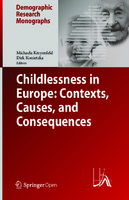Childlessness in Europe
Contexts, Causes, and Consequences
| dc.contributor.editor | Kreyenfeld, Michaela | |
| dc.contributor.editor | Konietzka, Dirk | |
| dc.date.accessioned | 2018-07-09 23:55 | |
| dc.date.accessioned | 2020-03-18 13:36:15 | |
| dc.date.accessioned | 2020-04-01T12:36:21Z | |
| dc.date.available | 2020-04-01T12:36:21Z | |
| dc.date.issued | 2017 | |
| dc.identifier | 1000237 | |
| dc.identifier | OCN: 1051778908 | en_US |
| dc.identifier.uri | http://library.oapen.org/handle/20.500.12657/29707 | |
| dc.description.abstract | In recent decades, levels of childlessness have been increasing rapidly in most European countries. German-speaking countries seem to be at the forefront of this development, as more than 20% of the women living in Germany, Switzerland, and Austria who are now reaching the end of their reproductive period will remain childless. But other European countries, such as the UK and Finland, also report high levels of childlessness. Eastern and Southern Europe did not have high levels of childlessness a decade ago, but are now seeing steady increases. This book provides an overview of the recent trend toward a “life without children” across Europe. It seeks answers to questions like: What are the determinants of childlessness in the twenty-first century? Is there an unbroken trend in childlessness, or is there evidence of trend reversals? How does the likelihood of remaining childless differ across social strata? To what extent do economic uncertainties affect childlessness? How do fertility desires evolve over the life course? To what extent does the situation of a woman’s partner affect her fertility decisions? How far can we push the biological limits of fertility? What role can assisted reproduction play in reducing childlessness? How many men fail to have children of their own? What impact can family policies have on fertility decisions? Can governments reverse the trend toward childlessness—and, if so, should they? | |
| dc.language | English | |
| dc.relation.ispartofseries | Demographic Research Monographs | |
| dc.subject.classification | thema EDItEUR::V Health, Relationships and Personal development::VF Family and health | en_US |
| dc.subject.other | Childlessness | |
| dc.subject.other | Demography | |
| dc.subject.other | Austria | |
| dc.subject.other | Fertility | |
| dc.subject.other | Finland | |
| dc.subject.other | Germany | |
| dc.subject.other | Sweden | |
| dc.subject.other | Switzerland | |
| dc.title | Childlessness in Europe | |
| dc.title.alternative | Contexts, Causes, and Consequences | |
| dc.type | book | |
| oapen.identifier.doi | 10.1007/978-3-319-44667-7 | |
| oapen.relation.isPublishedBy | 6c6992af-b843-4f46-859c-f6e9998e40d5 | |
| oapen.relation.isFundedBy | 7292b17b-f01a-4016-94d3-d7fb5ef9fb79 | |
| oapen.relation.isbn | 9783319446653; 9783319446677 | |
| oapen.collection | European Research Council (ERC) | * |
| oapen.collection | EU collection | * |
| oapen.pages | 367 | |
| oapen.grant.number | 324211 | |
| oapen.grant.acronym | FAMILIES IN CONTEXT | |
| oapen.grant.program | FP7 SC39 | |
| oapen.notes | 2018-07-09 19:27:58, ERC funding for Chapter 15: What’s a (Childless) Man Without a Woman? The Differential Importance of Couple Dynamics for the Wellbeing of Childless Men and Women in the Netherlands by Renske Keizer, Katya Ivanova | |
| oapen.remark.public | Relevant Wikipedia pages: Austria - https://en.wikipedia.org/wiki/Austria; Childlessness - https://en.wikipedia.org/wiki/Childlessness; Fertility - https://en.wikipedia.org/wiki/Fertility; Finland - https://en.wikipedia.org/wiki/Finland; Germany - https://en.wikipedia.org/wiki/Germany; Sweden - https://en.wikipedia.org/wiki/Sweden; Switzerland - https://en.wikipedia.org/wiki/Switzerland | |
| oapen.identifier.ocn | 1051778908 |

